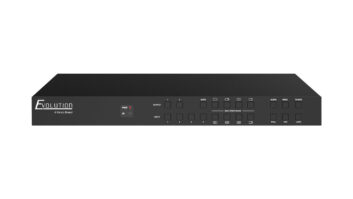NEW YORK — Consumer electronics retailers once again showed their resiliency last year by piling up double-digit sales gains amid a slowing economy.
Despite the tepid selling environment for most broad-line merchants during the latter part of 2000, the nation’s 100 largest CE dealers posted a cumulative 13.4 percent gain in consumer electronics revenue to cull a record $86.49 billion in sales, according to the latest TWICE CE Retail Registry.
Not that dealers didn’t take their lumps. Set against the backdrop of a nosediving NASDAQ, soaring energy prices, job layoffs and growing consumer angst, a series of high-profile bankruptcies and closures rocked the retail world last year, led by Retail Registry stalwarts Montgomery Ward, Bradlees, Heilig-Meyers and Roberds. That, along with increasingly cautious consumer spending, helped chip away at 1999’s aggressive 15 percent growth rate, when CE sales soared to a revised total of $76.26 billion.
What’s more, a goodly chunk of last year’s $86 billion-plus was no doubt derived from the rash of hard-hitting fourth-quarter promotions that filled the till with low- or no-margin gains.
Nevertheless, most CE stores correctly banked on consumers’ seemingly unquenchable thirst for the latest and greatest in digital technology, and parlayed their inventory investments in DVD players, HD-ready TVs, PDAs, and digital cameras and camcorders into robust retail sales.
Leading the charge once again were the usual Top 10 suspects, spearheaded by Best Buy with $13.02 billion in booty, and No. 2 CE chain Circuit City, which came away with $9.58 billion in spoils.
Best Buy attributed last year’s performance to its breadth of new digital technologies and the potent combination of a winning store format, product assortment and consumer shopping experience. But credit for its 14.4 percent sales gain must also go to the 54 new units that the company opened last year, including those in such heretofore-untapped markets as the metro New York area.
Circuit City’s 13 percent sales hike, which was a hair behind Best Buy’s and on par with the Top 100 average, was hindered by third-quarter store renovations that filled in major appliance floor space with quick-turn electronics and software. Although the construction work impeded foot traffic, the company is convinced its bold assortment reassessment ultimately boosted its CE revenue last year.
Perhaps the biggest news that the Registry has wrought is that of a new No. 3 player in CE land. Sears, dashing ahead 62.4 percent on a head of consumer electronics steam, leapfrogged CompUSA, RadioShack and Wal-Mart into Top 5 territory based on its $6 billion in CE sales last year (see story on p. 30).
With the exception of Sears, the Top 10 dealers remained static, although the jockeying for position was more intense farther down the line. Babbage’s Etc., the Grapevine, Tex.-based software chain, jumped from 45th place to No. 25 after snapping up FuncoLand, doubling its store count to 985 units and racking up a 136-percent sales increase to $575 million.
Also enjoying a new view from the Top 100 is Amazon.com. The e-tailer’s nascent CE store kicked into full swing in 2000 and trebled its sales volume to $603 million, earning it the 23rd berth on the Registry, up from 48th place last year.
Similarly, fellow cyber shop Outpost.com saw its CE fortunes soar 105 percent to $332 million last year, allowing it to move on up from 54th to 40th place. Also posting mighty gains was NECX Direct, an online technology superstore that was acquired last year by Gateway. Though primarily a business-to-business site, its consumer direct sales soared 75 percent to $117 million in 2000, catapulting it from the 77th slot to 67th place (see story, pg. 37).
And while 14th-ranked PC Connection was only rewarded with a one-notch gain for its efforts, its three-pronged approach to multi-channel sales — i.e. catalog, Internet and telemarketing — paid off handsomely with a 35 percent increase in CE sales to $1.42 billion.
Another CE retailer that gained substantial ground last year was Wall Street darling CVS Pharmacy. The national drugstore chain, ranked 88 last year, accelerated its CE business by 11 percent to $180 million without the benefit of new stores, landing it in 57th place. Conversely, Rite Aid, which sold $264 million in CE products with fewer storefronts, dropped from 44th to 50th place as store closures reduced its sales pace to a 5.6 percent rate of growth.
Other Registry declines were more precipitous. Service Merchandise, which spent the early part of 2000 removing itself from the consumer electronics landscape, fell from 17th to 45th on the Top 100 by successfully slashing sales 58 percent to $292 million, as it revamped its stores for a renewed jewelry focus.
Similarly, CDW Computer Centers dropped to 60th place from 51st as it continued to consolidate its business around the corporate, government and educational markets. Consumer sales at CDW fell to 4 percent of the mix last year from 7 percent in 1999, resulting in a 13 percent decline in direct revenue to $152 million.
Steeper still was Damark International’s plummet from 49th to 72nd as the company transitioned out of the catalog business to focus on its member-driven shopping club operation. In the process, CE sales fell 55 percent to $90 million. Likewise, the aforementioned Heilig-Meyers dived from 60th to 81st place as it shuttered over 300 stores last year in a desperate gambit for survival. As a result, CE sales plunged 40 percent to $75 million.
Examined by channel of distribution, the biggest market-share gains were enjoyed by the mass merchants and consumer direct contingents. Among the former, Sears’ explosive growth helped balloon total sector sales up to $19 billion, representing better than 22 percent of Retail Registry volume last year and besting its 20.7 percent share in 1999.
Also aiding the channel — and countering slimmer sales from Kmart, ShopKo and Wards — were double-digit sales gains by Wal-Mart and Target. Sixth-place Wal-Mart grew its CE business by 12.1 percent last year to $4.4 billion, while seventh-ranked Target saw its CE sales climb 11.8 percent to $4.08 billion — with 1,648 fewer stores than Wal-Mart.
The two discount giants upped the CE stakes by expanding dedicated floor space and assortment, and giving the category added emphasis online. Yet both continued to concentrate on quick-turn promotional vehicles like cameras, TVs and VCRs, keeping their distance from more esoteric electronics and leaving a safety zone for specialty stores.
Kmart, by contrast, grew its electronics business by a more modest 1.8 percent, as the chain grappled with its latest turnover in management and an attendant overhaul of business practices. Nonetheless, Kmart too was focused on building its online CE business and, like Wal-Mart, used low-end PCs and accessories as a lure.
The consumer direct class — which includes catalog, telemarketing, Internet and TV-based sales — also managed to muster more market share. The $7.17 billion that the channel garnered last year represented 8.3 percent of total Registry sales, up slightly from the 7.7 percent it held in 1999.
Aside from the aforementioned cyber stores, TV’s QVC (No. 32) and Home Shopping Network (No. 51) both enjoyed robust growth within the CE sector. The former saw its CE sales rise nearly 11 percent to $439 million, placing it within spitting distance of 31st-ranked Tweeter Home Entertainment Group. HSN, by contrast, enjoyed a whopping 34 percent hike in its electronics sales to $263 million, as the unit of USA Networks built its customer base to more than 5 million shoppers.
Category laggards included Damark and CDW, as well as 17th-ranked Micro Warehouse, which is shifting its mix away from consumer sales toward the business channel, resulting in a 4.7 percent decline in b-to-c revenue of $869 million.
On the distribution downside, consumers were apparently changing channels on the computer store sector. The $8.38 billion classification, lead by fourth-ranked CompUSA, gave back another percentage point of market share, bringing its Registry dominion down to 9.7 percent from 10.8 percent last year.
Despite solid showings by Babbage’s and 20th-place Micro Center (up 14.5 percent to $687 million), many of the category’s constituent dealers were flat to down for the year, including CompUSA. Notwithstanding a corporate overhaul that followed its acquisition in March 2000 by Mexican conglomerate and turnaround specialist Grupo Sanborns, sales for the company fell 5.6 percent to $5.5 billion amid a slowing market for personal computers.
Those market share shifts aside, the balance of volume by channel of distribution remained fairly static last year. Not surprisingly, the lion’s share of CE sales, at 28.5 percent, or $24.66 billion, is still held by the multimarket CE and/or appliance stores, which includes the likes of Best Buy, Circuit City, Fry’s and Rex. But while the group posted a nearly $3 billion gain over its record 1999 haul, its market share remains unchanged.
The story is similar for the electronics-only category, which encompasses such specialty CE chains as RadioShack, Ultimate Electronics, Tweeter and Good Guys. The sector’s billion-dollar sales gain only nudged its share of market up from 8.7 percent to 8.9 percent. Likewise, the home office triumvirate of Staples, Office Depot and OfficeMax, which is facing its own issues of market oversaturation and store consolidation, saw its CE share edge up two-tenths of a percentage point to 9.4 percent, while sales rose by about 1 billion dollars.
Regional CE and appliance retailers — i.e. independent dealers — continued to hold onto their slim 1.6 percent share of brown goods sales, which was unchanged from 1999. Sales for the group rose 11 percent to $1.37 billion.
Meanwhile, single-market superstores like P.C. Richard & Son, J&R Computer World and 6th Ave. Electronics, which find themselves on the front lines of store expansion by the national chains, also toughed it out last year to retain their 1 percent toehold in CE sales. Volume for this tier rose 16 percent to $924 billion.
Both groups, as well as the national chains, could take some solace in the fact that the warehouse clubs — the bane of the specialty store — actually lost share last year. While combined CE sales for Sam’s Club, Costco and BJ’s Wholesale rose nearly 9 percent to $4 billion, the channel’s market share slipped two-tenths of percentage point to 4.6 percent of total Top 100 sales.
Apart from bankruptcies, consolidation has also taken its toll on the Top 100 Registry. Gone from this year’s list are Douglas TV and United Audio Centers, which were snatched up last October and April, respectively, by Tweeter, and are expected to assume the corporate moniker this month.
Market Share Of Top 100
(a) All sales information, except for that supplied by publicly held companies that break out line-of-business sales for consumer electronics, is based on TWICE Market Research estimates.
Percentage totals may not add up to 100 due to rounding.
Source: TWICE Market Research ©TWICE 2001
CE Sales By Retail Channel/in $ millions
(a) Store type codes were developed jointly by TWICE and the Consumer Electronics Association.
(b) All sales information, except for that supplied by publicly held companies that break out line-of-business sales for consumer electronics, is based on TWICE Market Research estimates.
Source: TWICE Market Research ©TWICE 2001













